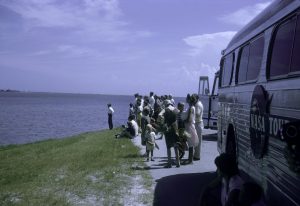
JHU faculty, students, and staff have access to Artstor and its more than 2 million images, including almost 77,000 images within open-access public collections, plus the 160,000 local images in the JHU Visual Resources Collection. Here Doctoral Candidate Emily A. Margolis discusses how her research led to new images being added to the JHU Visual Resources Collection in Artstor.
“Before NASA had finished constructing the Kennedy Space Center (KSC) the American public was clamoring for a glimpse inside. The Moonport, as it was known, would be the point of departure for the world’s first lunar explorers. In the summer of 1966 NASA instituted a public bus tour program, which welcomed over half a million visitors within the first year of operation.
My research examines the historical relationship between the American public and its space program through a study of KSC visitor programs during the Cold War. I ask: How did NASA choose to represent itself and why? What hopes, expectations, and concerns about space did visitors have? What did they take away from their visit to the space center, and how did this change their understanding and valuation of the space program?
Telling this story is a challenge for historians. While millions of people have snapshots and stories to share from their Moonport tours, these resources are stowed away in attic scrapbooks. There is no formal repository for these kind of memories. We can begin to understand the visitor experience thanks to Mr. Jon Proctor, who proudly served as a Moonport ambassador during the summer of 1966. As a driver-escort he guided visitors on their tour of the KSC facilities from behind the wheel of a Greyhound bus. He took many photographs during his stint at KSC, which have now been digitized and preserved by the Visual Resources Collection and are available to JHU faculty, students, and staff in Artstor.”
–Emily A. Margolis, Doctoral Candidate, History of Science and Technology
Need help using Artstor? Contact the VRC at vrc@jhu.edu, and visit the Visual Resources Collection guide for more information. Download the VRC’s Artstor at JHU Quickstart Guide for the basics of using Artstor. Need images not available in Artstor? Click here to access our interactive pdf order form.
For more ways to find images, see the Images page on the library’s Art History guide and see the Finding Images guide.
